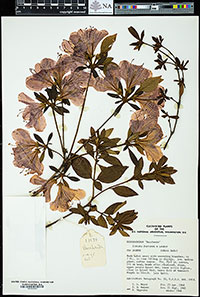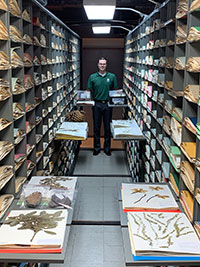U.S. National Arboretum Herbaria

What is an Herbarium?
An herbarium (plural: herbaria) is a collection of preserved plant specimens used for scientific research. It is similar to a library filled with primary sources, providing scientists with hands-on access to plant materials. Herbarium specimens are necessary for studies in taxonomy, ethnobotany, ecology, phylogenetics, biogeography, and many other fields.
History
The United States Department of Agriculture (USDA) has maintained herbarium collections since about 1868. Plant and seed material of crop or economically important species was of particular interest to the Department, and scientists began collecting and preserving these samples shortly after USDA’s establishment in 1862. Over the next century, these collections grew in size and scope and were relocated several times, finally coming to the U.S. National Arboretum permanently in 1964.
The U.S. National Arboretum Herbaria Today
Today, the U.S. National Arboretum maintains two separate herbarium collections: the U.S. National Arboretum Herbarium (cited internationally by the code ‘NA’) and the U.S. National Seed Herbarium (code ‘BARC’).
The U.S. National Arboretum Herbarium houses around 700,000 specimens, approximately 25% of which are from cultivated, rather than wild, plants. This emphasis on cultivated plants makes the herbarium here unique; it is one of the largest such collections in the United States.

Among the important specimens housed here are germplasm vouchers, material from USDA-sponsored expeditions, documentation of plant invasions, and collections of notable botanical explorers. The herbarium also has over 2500 type specimens (those upon which the description and name of a new species is based) and nearly 2000 cultivated nomenclatural standards (authentic material to which a cultivar name is attached).
The U.S. National Seed Herbarium dates to around 1914 and contains approximately 150,000 vials and packets of preserved seeds and fruit and is the largest, most comprehensive collection of its kind in the world. The seed herbarium is a resource for researchers across the biological scientists, but is used primarily by botanists with the USDA’s Animal and Plant Health Inspection Service (APHIS) to aid in identifying foreign seeds that may enter the country and cause harm to the United States’ agricultural biosecurity.
In 2021, the entirety of the NA Herbarium was digitized; we now have high-resolution images and core collection metadata for every specimen in this collection. A “virtual herbarium” database is currently under development and we anticipate launching this publicly accessible portal in late 2023. The type and standard specimens can currently be found through the JSTOR Global Plants database. Although the BARC Herbarium has not been digitized on a large scale, images from some of the collection’s samples can be found across the USDA PLANTS Database.
For access to these materials or to schedule a tour of the collections, contact the Curator.
Contact Information
Dr. Harlan Svoboda, Curator
Harlan.Svoboda@usda.gov
202-245-2715
3501 New York Avenue NE
Washington, D.C. 20002